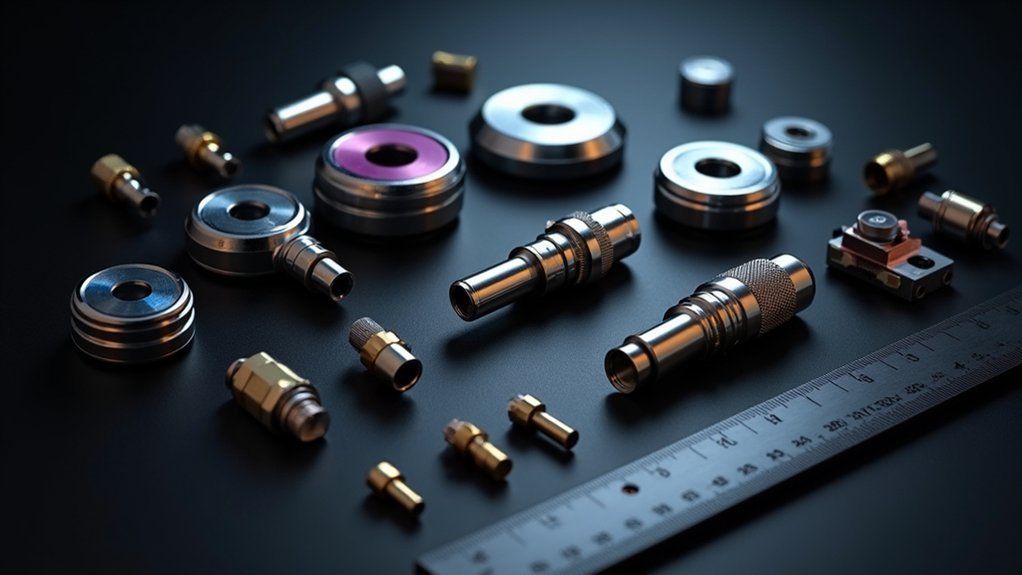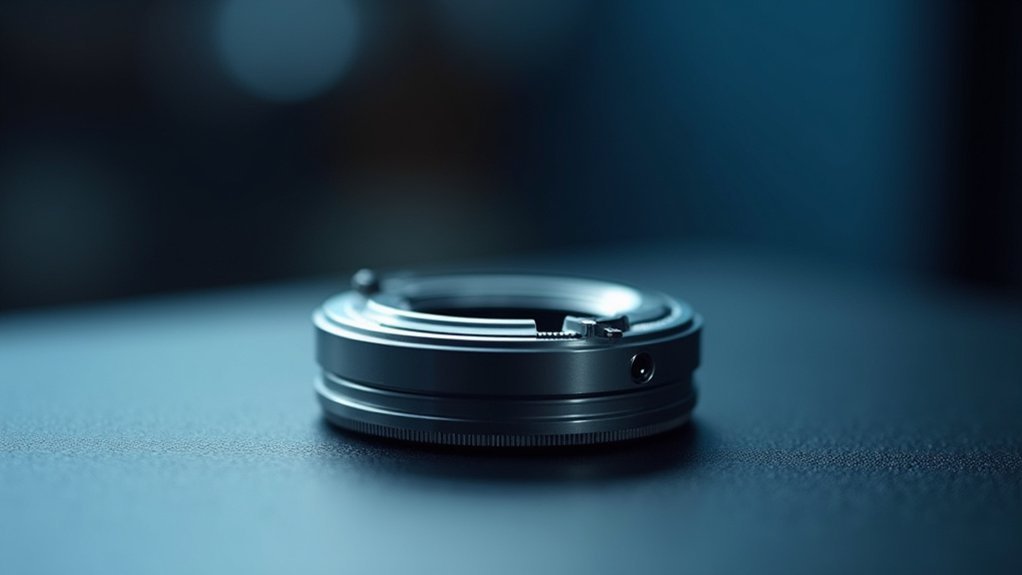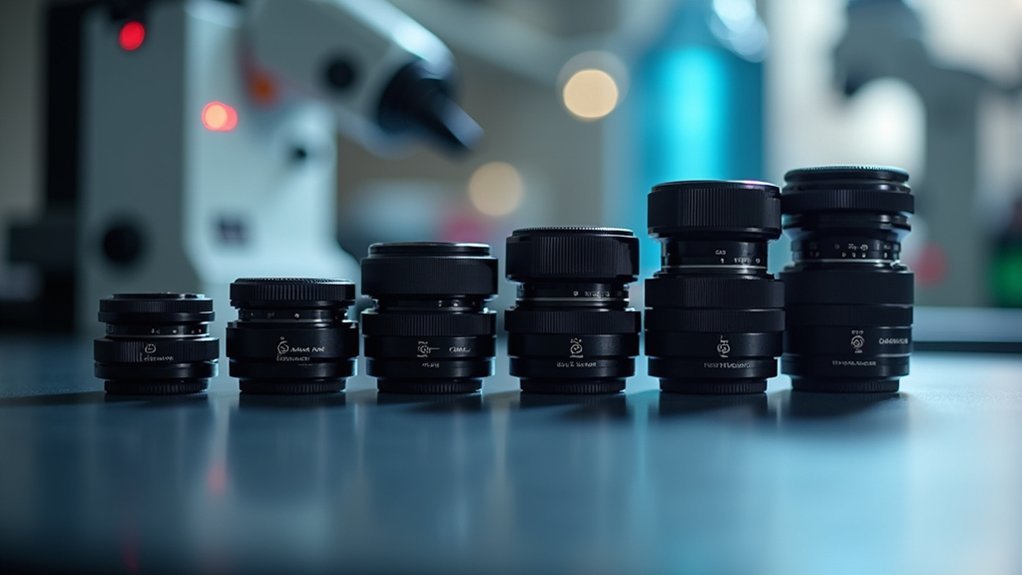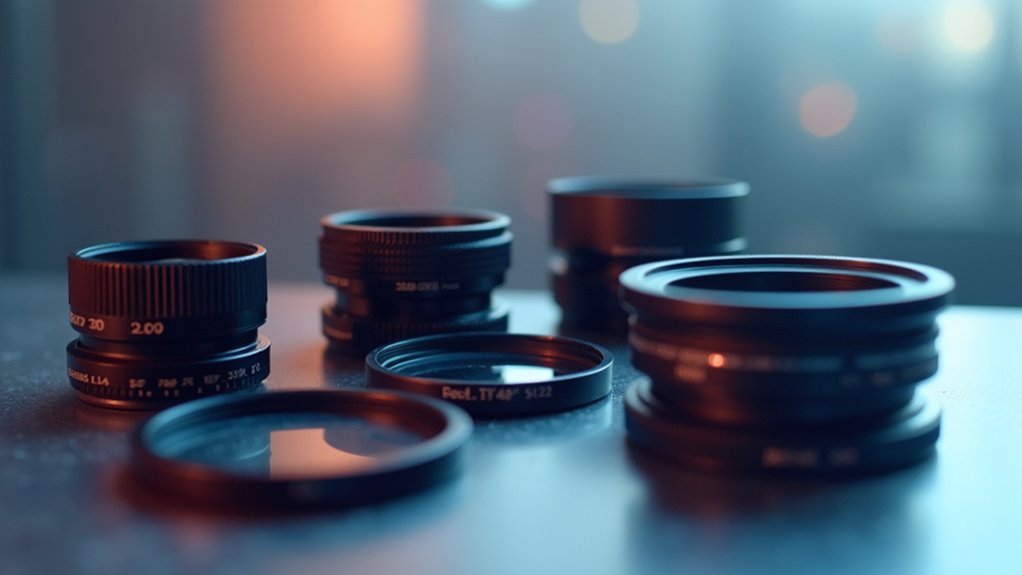When selecting adapters for scientific imaging, match your camera’s sensor size with the appropriate mount. Smaller sensors (1/4″) work best with 0.265x-0.3x C-mounts, while larger formats like APS-C benefit from F-mounts to prevent vignetting. Consider your application’s specific needs—balancing field of view, light transmission, and resolution quality. You’ll need different configurations for routine microscopy versus specialized research, affecting both magnification and image clarity in your results.
Understanding Image Sensor Formats for Microscopy

When selecting a camera for microscopy applications, understanding image sensor formats is essential for achieving the finest results.
Image sensors come in two main categories: inch-based formats (1/3″, 1/2″, 2/3″, 4/3″) for smaller sensors and APS formats for larger ones exceeding 4/3″.
Your microscope camera’s sensor size directly impacts magnification and resolution. Smaller sensors like the 1/2″ format (8.00mm diagonal) typically deliver higher magnification, while larger sensors such as APS-C (26.7-28.4mm diagonal) offer better resolution.
Choosing the right C-mount adapter depends on your camera’s chip size. For example, if you’re using a 1/4 chip camera, you’ll need a 0.265x or 0.3x adapter to maintain proper magnification.
This compatibility guarantees peak imaging performance in your scientific applications.
The Evolution From Inch-Based to APS Sensor Systems
The shift from inch-based to APS sensor formats represents a critical evolution in scientific imaging that you’ll need to understand for ideal results.
When working with sensors larger than the 4/3″ threshold, you’re now dealing with APS measurement conventions that offer more precise dimensional specifications and better alignment with modern camera standards.
These newer APS formats provide you with enhanced imaging capabilities through larger sensor diagonals, ranging from 26.7mm in APS-C to 43.2mm in full-frame configurations, considerably impacting resolution and depth of field in your scientific applications.
Sensor Measurement Transition
As digital imaging technology surpassed the limitations of traditional 4/3″ formats, a significant alteration occurred in how manufacturers measured and classified image sensors. This shift moved away from the fractional inch-based system toward the more precise Advanced Photo System (APS) standards.
You’ll notice that APS format sensors provide clearer specifications of actual imaging area compared to their predecessors. While older systems used confusing fractions that didn’t directly correlate to physical dimensions, APS formats use exact millimeter measurements for sensor sizes. This standardization makes it easier for you to understand the true capabilities of your equipment.
The change wasn’t merely semantic—it represented a technological evolution from early vidicon tubes to advanced solid-state sensors, delivering superior image quality and expanded creative possibilities for your scientific imaging applications.
APS Format Applications
Evolving beyond the inch-based measurement system, modern scientific imaging now embraces the APS format standards with remarkable precision and utility. The shift provides consistent sensor size descriptions across digital camera systems used in microscope-specific applications.
When selecting imaging equipment, you’ll encounter three primary APS formats: APS-C (26.7-28.4mm diagonal), offering excellent balance for routine microscopy; APS-H (33.5mm diagonal), providing enhanced detail capture for specialized research; and Full-frame/APS-F (43.2-43.3mm diagonal), delivering superior resolution for demanding scientific applications.
These standardized formats have revolutionized microscope adapter compatibility, allowing you to match optical systems precisely with your imaging requirements.
The widespread adoption of APS formats guarantees that your scientific imaging setup benefits from optimized light capture and field coverage across various magnification levels.
Matching C-Mount Adapters to Your Camera’s Sensor Size

You’ll need to carefully match your C-mount adapter to your camera’s sensor size to achieve ideal imaging results.
With smaller 1/4″ sensors requiring 0.265x or 0.3x adapters and larger 1/2″ or 1/1.8″ sensors working best with 0.45x to 0.6x options, selecting the wrong adapter can lead to non-parfocal images and distorted fields of view.
Remember that your sensor’s dimensions directly impact magnification—smaller sensors inherently provide higher magnification—making this relationship a critical factor in your adapter selection process.
Optimal Adapter Selection Guidelines
Selecting the right C-mount adapter for your camera requires careful consideration of your image sensor’s dimensions to achieve excellent results. When your adapter doesn’t match your sensor size, you’ll experience reduced image quality and field of view limitations.
| Sensor Size | Recommended C-mount Adapter | Use Case | Eyepiece Compatibility | Image Quality Impact |
|---|---|---|---|---|
| 1/4-inch | 0.265x or 0.3x | Microscopy | 10x | Optimal clarity |
| 1/3-inch | 0.3x | Standard lab imaging | 10x-15x | Full field coverage |
| 1/2-inch | 0.45x to 0.6x | General documentation | 10x | Balanced resolution |
| 2/3-inch | 0.7x | Detailed analysis | 15x-20x | Enhanced detail |
| 1-inch+ | 1.0x | Research-grade imaging | 20x+ | Maximum resolution |
For excellent results with a 20x eyepiece, you’ll need a higher magnification adapter to maintain focus across your entire sensor area.
Sensor-to-Magnification Ratios
The relationship between your camera’s sensor size and the C-mount adapter magnification forms the foundation of successful scientific imaging.
When selecting adapters, you’ll need to match them precisely to your sensor dimensions for ideal results.
For smaller 1/4″ sensor cameras, choose 0.265x or 0.3x reduction adapters, while 1/3″ sensors work best with 0.3x C-mount adapters.
If you’re using a 1/2″ sensor with a 10x eyepiece, opt for 0.45x, 0.5x, or 0.6x adapters to achieve balanced magnification ratios.
Larger 2/3″ sensors typically require 0.7x C-mount adapters to properly align with eyepiece specifications.
Remember that higher power eyepieces (like 20x) will necessitate adjustments to these standard recommendations, as magnification ratios must be recalibrated to maintain appropriate field of view.
Field of View Considerations When Selecting Adapters
When choosing adapters for scientific imaging, understanding how they influence your camera’s field of view (FOV) is essential for perfect results. Your camera sensor dimensions directly impact what you’ll capture—larger sensors provide broader views while smaller ones yield narrower perspectives.
Precise adapter selection directly determines what your camera captures—the gateway to successful scientific imaging results.
For best image quality, verify your adapter properly matches the sensor size to your microscope’s optical system. Standard microscope C-Mounts typically accommodate up to 22mm FOV, making them unsuitable for larger sensors which require F-mounts instead.
When working with different eyepieces, remember that adapter selection affects your effective FOV—20x eyepieces generally need higher magnification adapters than 10x ones.
Consider that relay lenses can modify your FOV; demagnification optics expand coverage but might sacrifice resolution. Proper matching prevents vignetting and guarantees clear, full-frame images.
Resolution Trade-offs Between Sensor Dimensions and Magnification

Understanding resolution trade-offs requires balancing sensor dimensions with magnification needs in scientific imaging applications.
When you use smaller sensors (1/4″ or 1/3″), you’ll achieve higher magnification but may compromise image resolution due to pixel density limitations.
Larger sensor sizes, particularly APS-C formats, offer superior resolution and image quality with wider fields of view and reduced magnification distortion.
In microscopy imaging, matching your sensor size to the appropriate c-mount adapter is critical to prevent non-parfocal images and detail loss.
While smaller sensors provide greater magnification, they sacrifice the clarity that larger sensors deliver.
For ideal scientific imaging, you’ll need to select adapters that complement your sensor dimensions, especially when using full-frame sensors which can dramatically improve resolution if paired with appropriate optics.
Camera Mount Types and Their Compatibility With Various Sensors
Selecting the right camera mount proves critical for achieving perfect scientific imaging results, as different mount types offer varying compatibility with sensor dimensions.
C-mount adapters, with their standard 1-inch thread design, work well with smaller sensors but limit your FOV to 22mm maximum, restricting their use with larger sensors.
For larger sensors exceeding 22mm, F-mounts provide an excellent solution with their bayonet-style connection and longer back focal distance.
T-mounts offer versatility across different camera manufacturers, making them adaptable to various sensors used in scientific imaging.
When choosing adapters with additional optics like relay lenses, you’ll face trade-offs between image quality, FOV, and pixel resolution.
Your selection should be guided by your specific sensor size to guarantee ideal compatibility and imaging performance.
Optimizing Adapter Selection for Specific Scientific Applications

As various scientific disciplines demand different imaging requirements, the precise matching of adapters to your specific application becomes essential for achieving ideal results.
When selecting adapters, consider your camera sensor size first—smaller 1/4″ chips typically need 0.265x or 0.3x reduction lenses with C-mount adapters, while larger APS formats benefit from F-mounts to prevent vignetting.
Your eyepiece magnification also influences adapter choice. For instance, if you’re using a 10x eyepiece with a 1/2″ chip, you’ll want a 0.45x, 0.5x, or 0.6x C-mount adapter for best image quality.
Remember that adding optics creates trade-offs between effective pixel size and resolution. Always prioritize maintaining field of view while ensuring sufficient light transmission to your sensor for the best scientific imaging outcomes.
Frequently Asked Questions
How to Calculate Image Sensor Size?
To calculate image sensor size, you’ll need to measure the diagonal length of your sensor in millimeters. You can convert from inch formats by multiplying the fraction by 25.4 mm (1 inch).
Is Super 35 Bigger Than APS-C?
Yes, Super 35 is bigger than APS-C. You’ll find Super 35 has a diagonal of about 28.4mm and width of 24.89mm, while APS-C measures 26.7-28.4mm diagonally with 22.2-23.7mm width.
What Is a C-Mount Adapter?
A C-mount adapter is what you’ll use to connect your microscope camera to a trinocular port. It has a 1-inch diameter thread and includes special lenses to match your eyepiece magnification.
Is Super 35 Bigger Than Micro 4 3?
Yes, Super 35 is bigger than Micro Four Thirds. Your Super 35 sensor has a diagonal of 28.4mm versus Micro Four Thirds’ 21.6mm, offering you better low-light performance and shallower depth of field.
In Summary
You’ll achieve ideal results by matching your camera’s sensor size with the appropriate adapter. Remember, larger sensors require different optics than smaller ones to capture your specimen’s full field of view. When selecting your imaging setup, consider both the physical connections and how the sensor dimensions impact your resolution. By understanding these relationships, you’ll maximize image quality and guarantee your scientific imaging meets your specific research requirements.





Leave a Reply